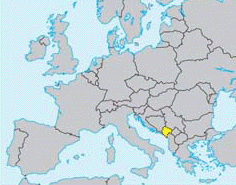Children of Montenegro
Realizing Children’s Rights in Montenegro

Montenegro is committed to the protection of children, proven by their ratification of the International Convention of the Rights of the Child and its optional protocols. Even as the country puts programmes in place to fight discrimination, particularly towards disabled children, though, the authorities are faced with the persistence of this deeply rooted phenomenon in society.
Population: 0.6 million Life expectancy: 74,8 years |
Main problems faced by children in Montenegro:
Differences in treatment with regard to access to education and to healthcare persist for refugee and disabled children, as well as for those from minority groups.
 Although the country has implemented a strategy to improve the situation for Roma communities, Montenegro recognizes that a significant number of these children are not enrolled in compulsory primary education.
Although the country has implemented a strategy to improve the situation for Roma communities, Montenegro recognizes that a significant number of these children are not enrolled in compulsory primary education.
One of the reasons for this is the absence of lessons in their native language and the difficulty of providing them with basic lessons in Montenegrin before they start primary school.
Whilst a programme is making provisions for the recruitment of classroom assistants to help Roma children to fit in and to overcome linguistic difficulties, the educational system is faced with a shortage of candidates with the necessary qualifications for these posts.
Furthermore, many Roma children live in isolated areas or in refugee camps, so it is not easy for them to get to school.
The unclear legal status of Roma, Ashkali and Egyptian (RAE) families constitutes a barrier to access to health insurance.
Access to health services is also limited and inequitable outside of the capital. As such, Roma, refugee and disabled children are the worst affected.
The Committee on the Rights of the Child is concerned about the fact that numerous Roma families live in poverty, and so are deprived and isolated with appalling living conditions.
The country has a large number of displaced persons, yet few of them are registered and have identity documents.
In the absence of these documents, it is difficult for parents to register their children.
In connection with the strategy to improve the situation for the Roma population, the country should have helped in the granting of personal documents. However, in 2011, Montenegro very rarely followed through on this initiative.
The legality of corporal punishment in the country favours this practice in the family, in institutions, and in the legal and school systems. Moreover, disabled children are very often victims of this current practice.
The subsantial number of children that have been abused or sexually exploited and the fact that few of people who engage in violence against children have been prosecuted for their actions also constitutes cause for concern.
While the implementation of legislation and measures adapted for minors is recommended, the laws and procedures applied in Montenegro for children are similar to those for adults.
This is despite the fact that studies have shown that a legal system dedicated to minors helps to produce the best results.
The country is not exempt from the problem of children living and working on the streets, the majority of whom are of Roma origin. These children are therefore vulnerable and easy prey for those involved in trafficking and sexual exploitation.
Data
According to the International Convention of the Rights of the Child, it is vital that States establish mechanisms for the collection and analysis of data in order to monitor and evaluate the impact of policies adopted in the interest of children.
Nevertheless, in 2010, the Committee on the Rights of the Child acknowledged a lack of data collection from Montenegro.






